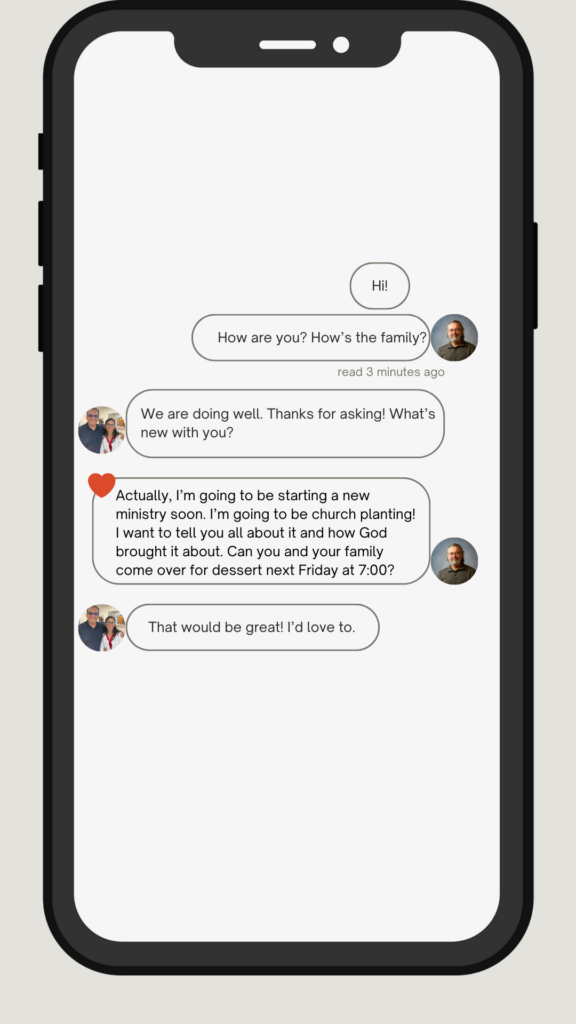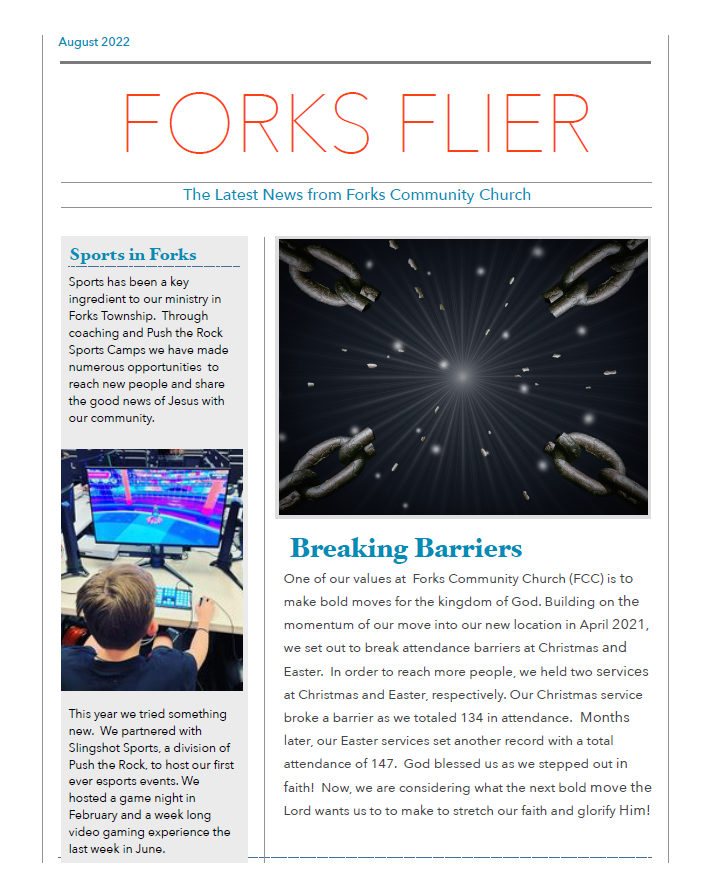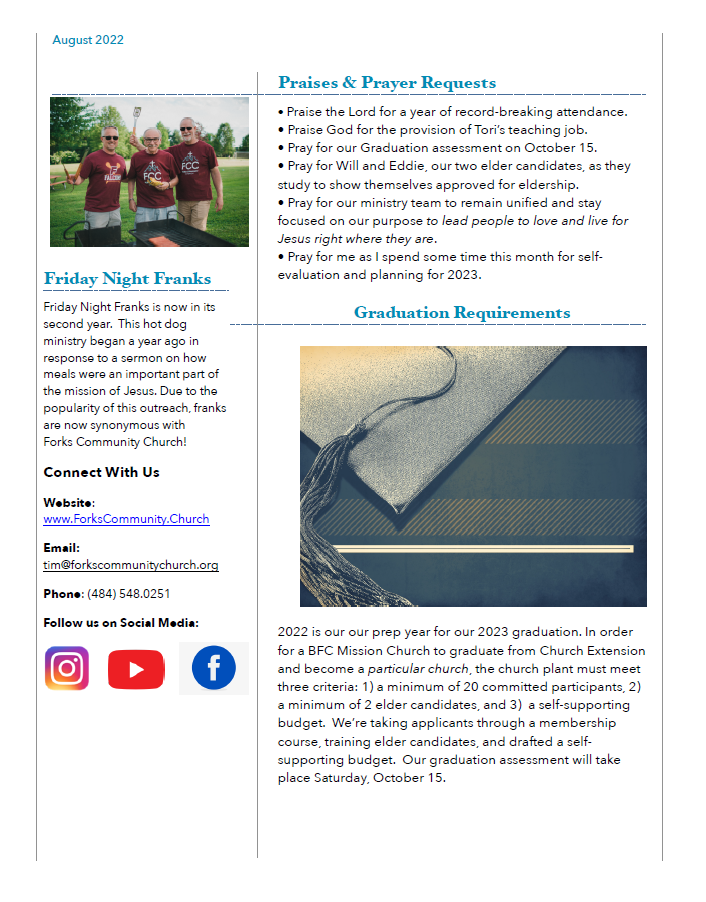Congratulations! You are ready to be a Church Planter or Church Planting Intern! There’s just one more thing to do: raise support. If your stomach just flip-flopped and your skin went clammy, then this is the handbook for you. We will walk with you through this process. Over and over again, Church Extension has seen God provide for church planters and we are confident that He will provide for you, too. The key is to focus on finding partners rather than just concentrating on financial support.
Seven Steps to Partnership Development

At Church Extension, we use the term “partnership development” rather than “raising support.” Partnership development is not just gathering individuals and churches to send money for your ministry. It’s about creating a relationship between God, them, and you so that together you can see how the Lord works to build His church. When you are faithful to share what God is doing in you and through you and your Mission Church, He will move in the hearts of the listeners to give and to pray.
Here are the steps to take in order to find ministry partners for your church planting mission:
- Understand the Biblical Basis for Partners
- Prepare What to Share
- Namestorm Potential Partners
- Contact Potential Partners
- Write Prayer Letter
- Meet with Potential Partners
- Follow Up
Throughout all these steps, the most important part is prayer! God is the one who will be providing for your ministry through His people. Seek His face every day. Know that the Church Extension director, assistants, and office staff are joining you in prayer and rejoice in the Lord as His provision flows in.
Step 1: Understand the Biblical Basis for Partners
God has not designed us to minister on our own. He has designed the church to consist of men and women and children to work together to share the gospel and to bring God glory. Asking for ministry partners is a natural part of “one anothering” within the universal church. Paul used the term “partnership” when he thanked the Philippians for their participation with him in the work of sharing the gospel which included taking care of Paul’s physical needs through giving (Philippians 1:5, 2:25, 4:10-19).
Scripture supports a direct-ask approach to finding partners including a direct-ask for financial support.
- Moses directly asked the Israelites to give their gold and goods towards the building of the tabernacle (Exodus 25).
- Elijah directly asked the widow of Zarephath to give him water and some bread (1 Kings 17).
- Jesus sent his disciples to directly ask a man for use of his donkey on Palm Sunday (Matthew 21:3).
- Jesus and the disciples received support from women followers (Luke 8:2-3).
- Paul built the case that those who preach the gospel can receive their living from the gospel (1 Corinthians 9:1-8) and reminded the Corinthians to be ready to give as they had promised (1 Corinthians 9:5).
In each of these examples, the direct-ask was stating a specific need and asking the listeners to give. There was no pushy, overbearing, bossy demand to give. God has told believers to give cheerfully what they have decided in their hearts to give, not reluctantly or under compulsion (2 Corinthians 9:7). Therefore, as a church planter, you are not responsible to make people give through the direct-ask, but simply to share your specific need and then leave room for the Holy Spirit to work in the listener’s heart so that the person’s giving can be done cheerfully and freely.
Step 2: Prepare What to Share
Since your task is to share your specific need, prepare several different kinds of presentations so you can share your financial support need clearly and concisely.
- The Elevator Pitch: Prepare a 30 second or less version of your ministry and vision. Include what you will be doing as a church planter, where you will be doing it, and why. For example, Church Planter Dan Hoffstetter would share “my mission is to plant a church in Topton, PA in order to give the community the hope of the gospel. There are no gospel-preaching churches in the town at present.” Right away the potential partner knows what Dan will be doing and why the ministry is so important. The Elevator Pitch presentation will allow you to quickly share your need with someone you bump into at the grocery store or reunite with on Facebook. As your financial support starts to come in, you may also want to include in your elevator pitch the specifics of how close you are to your support need such as “we need $5,000 per month to be fully supported and we need $2,000 more to meet that goal.” It’s also helpful to share the need in terms of small support levels. For example, “I need 100 people to give $20 a month.” This breaks the goal down to a doable amount for the donor. Exact numbers and goals help potential supporters get a concrete picture of how they can be a helpful partner.
- The Full Presentation: Prepare a more complete presentation of your ministry for when you have the opportunity to share with potential partners face to face or in a group. Twenty to thirty minutes is sufficient for this type of presentation.
For this longer presentation, remember to include:
- How God led you to be a part of this ministry opportunity. How did God bring church planting to your attention? Do you have church planting or church ministry experience? Why are you church planting in your particular chosen location?
- Who is on your church planting team? Will your wife and family be involved in a particular way? Include particular stories of your launch team members and how God has led them to your team as well.
- Your financial need and how your support is handled. Include the dollar amount of your monthly support need and what percentage you have pledged to you so far. This number will always be changing. Contact CEMoffice@bfc.org to get up to date reports on what pledges have come in so far.
- Suggest a range of giving appropriate to your listeners. Encourage monthly or quarterly giving. Don’t beat around the bush. A direct ask is scriptural (James 4:2).
- Give specific instructions about how to give. By check to Church Extension Office or online at churchplantingbfc.org/donate. Online they can set up a recurring gift. When they give by check, they will receive a receipt along with a return envelope to send in their next gift which makes recurring giving by mail easy. If you are meeting with someone face to face, have a business card or flyer or other slip of paper with the giving instructions already laid out.
- Visuals and Handouts: Create a variety of visuals to go along with your presentation. A simple flyer with the basics of your ministry and contact information and instructions on how to give is easy to hand out to potential partners. You can also create a webpage or ask the Church Extension office to create a simple webpage with the information so you have something digital to share. Business cards are also an easy way to share your need and how to give. A PowerPoint presentation with pictures of your mission church area and people on your team would be helpful. Include charts about the population and other statistics about the neighborhood and city of your mission church. You can find these in your demographic study.
We are aware that the direct-ask presentation approach may not feel natural in all cultures. Or you may not have an extensive network of contacts. For example, our Hispanic Ministry Director, Carlos Rodriguez, came to the United States from Mexico to church plant in Reading, PA. Partnership development was not an easy concept for him coming from Mexico and coming to a place where he knew nobody. However, Director Gundrum introduced Carlos to our existing network of churches and individuals who are always eager to hear about new mission churches and church planters.
Carlos was able to gather partners through our existing contacts. The same has been true for other Hispanic church planters and planters who were new to the BFC. That is one of the advantages to church planting with the Bible Fellowship Church; an accessible network is already in place.
Step 3: Namestorm Potential Partners

In this step, brainstorm or “namestorm” as many people you can. List everyone you have known your whole life. Ask your spouse or kids to join in the namestorm. You can start this step as soon as you feel the Lord is moving you towards church planting.
- Pray that the Lord will bring names of people to your mind.
- Set a timer for 15 minutes and write down EVERY name who comes to mind. If you think of the name, write it down. Do not assume that someone won’t give or try to filter your list of names at this point. Don’t get sidetracked looking for contact information. Just write! Don’t forget to include:
- Former Churches and Pastors
- Key people in your life (Sunday School teachers, youth leaders)
- Fellow college students, families that you shared time with growing up
- Co-workers, neighbors
- Extended family members, even ones you haven’t been in contact with recently
- Acquaintances and friends from hobbies in your life or in your family’s life
- Keep the list fluid once it is started. The Holy Spirit will bring more names to mind as you go along.
- Once you have come up with the list of names, prioritize who is most likely to give based on their close association with you relationally. This is not to discount the others on your list, but helps you know where to start in the next step.
Step 4: Contact Potential Partners
The goal in this step is to contact the people from your namestorm list and to schedule times to meet with those who are close to give a direct-ask for partnership, both prayer and financial support. You may also ask for people to partner with you by joining the launch team or mission church indefinitely or for a short-term commitment.
- Whether or not you get to meet with potential partners in person, ask if you can include them on your snail mail prayer letter list or your email prayer letter list. The Church Extension Office will be asking for at least 200 snail mail addresses so that we can use our bulk mail rate for your prayer letter.
- Meet with the leadership of your current church. By contacting the church first, you recognize the church, your pastor, and your elders as your spiritual leaders and seek their approval on proceeding to enlist support in the church. Find out if your church will give from the church budget or if they prefer to leave it up to individual members. Ask your church leaders how you can present your ministry in the church. Suggest visiting small groups, Sunday school classes, and Bible studies.
- Next, contact the individuals on your namestorm list. Schedule times to meet face-to-face. You don’t need to give all the information about your ministry when you ask to meet. Save the bulk of the info for your meeting. For example, Church Planter Tim Zuck would call or message a friend: “I have exciting news to share about a new ministry God has put on my heart. Is there some time that we could meet so I could share the ministry with you? I’d also love to hear how you are doing.” Have a good system for keeping track of your appointments. You can also schedule meetings with small groups as well as with individuals. Have several families or individuals over at your home and give your presentation while dessert is served. Schedule a Zoom meeting or phone call with people who live far from you.
- Gather the names and addresses and/or email addresses on a spreadsheet and send them to CEMoffice@bfc.org so that Church Extension can prepare to send out a prayer letter for you.

Step 5: Write Prayer Letter
Once your Mission Church is opened as an official mission or you are called as a Church Planter, the Church Extension office will send out your prayer letter to your partners and ours. We will supply you with a sample Excel spreadsheet to fill in with the names you collect.
At Church Extension, your prayer letter will not only go out to your contacts whom you have gathered yourself, but there are about 150 partners of Church Extension as a whole who will receive your letter. Your letter may be read by complete strangers! Keep this in mind as you are writing your initial prayer letter!
Your prayer letter should include:
- The story of how God led you to this particular ministry
- one page, front and back which only fits about 800 words
- Three-five pictures of you and your ministry team or the area of your mission church
- An eye-catching title and attractive layout such as the templates on Word, Publisher, or Canva
- your email address, phone number, or social media handles so that people can contact you directly.
- A specific ask for prayer for your ministry
- The specifics of your financial need
- Specific personnel needs if you’d like more people to join the launch team or attend the mission church
- Explanations of acronyms or church planting terminology since not everyone reading the letter will know the ins and outs of the BFC or of church planting in general
The office will provide an additional response card to go out with the mailing. Once your prayer letter is completed, email a PDF and the original file to CEMoffice@bfc.org.


Step 6: Meet with Potential Partners
Once you have your first prayer letter written, you will have an easy handout to give to people as you meet them face to face. Work through your schedule of appointments to share your ministry. Include a direct question asking the person to support you, but don’t require an answer on the spot. Some people may pledge financial support if they have prayed about it ahead of time, but others may need time for prayer and to talk to their spouse.
Don’t forget to listen as well as talk. Ask your contact how they are doing and how you can be praying for them in their life and ministry. Ray Bertolet, Assistant Church Planter, makes sure to pray for his partners and check in with them regularly including sending them periodic thank you notes and birthday greetings. Your partners are also serving the Lord in various ways and your prayer partnership can go both ways.
Step 7: Follow Up
- Personally thank each individual and church who informs you that they will be supporting your ministry. This can be a note, a card, a text message, or a social media message. A personal thank you is much appreciated! At Church Extension, you will have access to who has been giving to your ministry through the reports in DonorSnap. If you have questions about accessing these reports, email CEMoffice@bfc.org. Your donors will receive a receipt and a thank you from the office, but a personal thank you is more memorable.
- Visit your supporting churches when you are able.
- For those you have met in person, follow up with a note thanking them for the opportunity to meet. If they mentioned needing time to pray about support, ask them if they had time to think and pray about it.
- If someone gives you a verbal commitment to support you, be sure to follow up with specific instructions about how to begin the giving and where to give after your meeting. They can give online at ChurchPlantingBFC.org/Donate or by check to Church Extension Ministries, PO Box 3534, Allentown PA 18106.
- Start regular monthly or bimonthly emails for your partners. The office only sends out a letter once a year on your behalf. To stay connected, financial partners will want to hear from you more often. Mailchimp, MailerLite, Substack, or Constant Contact are just a few of the email programs that can help make this process easier.
- Share “success stories.” Once your ministry gets going, share what God is doing through your ministry. Individual stories can be so effective to help people have concrete examples of what your ministry is doing and make it exciting to be a part of.
- People like to see the percentage of financial partnership grow. Include that information in your email updates.
- Use social media to keep in contact with your partners. Post regularly to show what you are doing and what the Mission Church is doing. Follow Christ Alone Fellowship and Church Planter Los Morales on Facebook for a good example of regular posting to keep in contact with partners. He often posts snapshots of Bible studies, his sermon preparation, showing building needs, who he is meeting with for lunch, and other thoughts about church planting. To keep social media from being overwhelming, Los has chosen to only use Facebook so as to not become overwhelmed. He also has a volunteer from the Mission Church post on the church’s account on both Facebook and Instagram.
Words of Encouragement
A step by step guide to partnership development might make it look formulaic for guaranteed partnership, but we know partnership development is not easy. Here is some encouragement for you:
- Remember to pray. Pray consistently on your own, with your family, and with your church. Prayer reminds us that the task of finding ministry partners is God’s work and not ours. Praise the Lord as partners make commitments to you.
- Don’t overthink it. Don’t wait until the time is just perfect to get started with finding partners. Just start now. Start with the easy people to meet with and build confidence from there.
- Don’t give up. If you reach a plateau and have run out of names of people to ask for partnership and feel that you will never reach full support, don’t throw in the towel. Remember that God who has brought you this far will not leave you. He will provide for you and the ministry He has laid out for you. Pray for a solution for where you are stuck and it will come. Reach out to the Director and the Church Extension office staff and we can help you and pray with you.
- Guard your heart from bitterness. Each month you will be looking at reports about who gave what. Some of the totals may be frustrating to you if you know someone could give more or someone promised to give and their name still doesn’t appear on your report of givers. Maybe your home church isn’t giving much despite your many years of faithfulness there. Make a choice to look at your report with gratitude and pray for the people on your report with thanksgiving.
Continue to pray on your own and with others that God will provide your needs. Give Him glory as He provides. Remember that Church Extension is here to help you. If you need guidance or support along the way, please don’t hesitate to ask.


